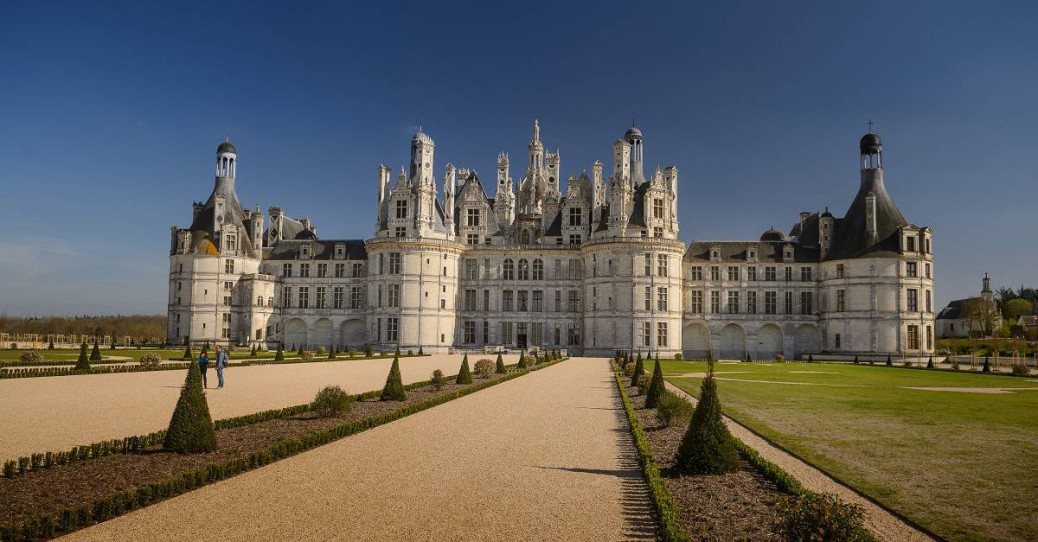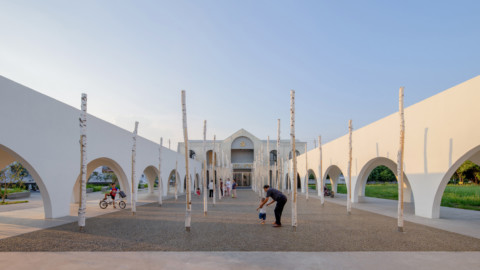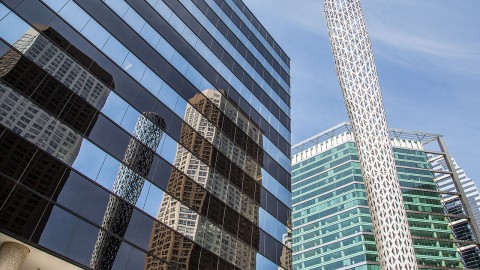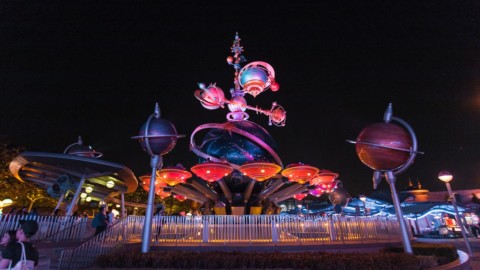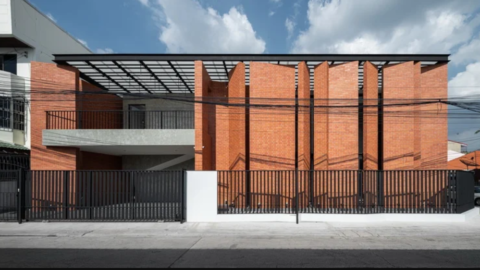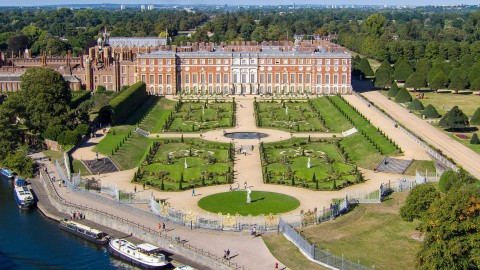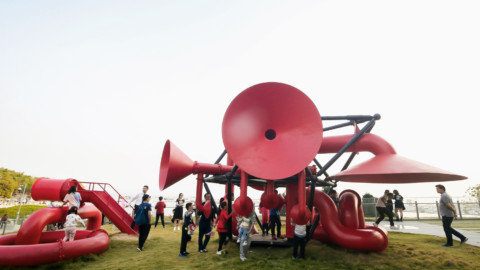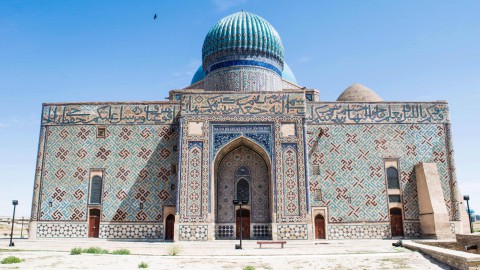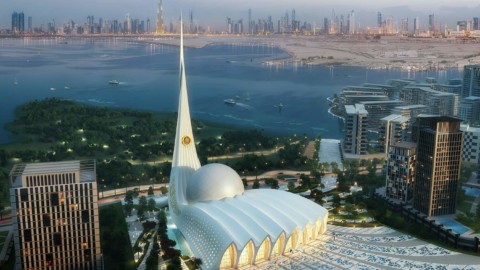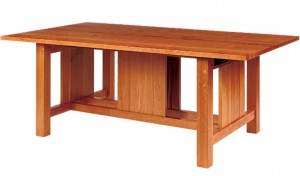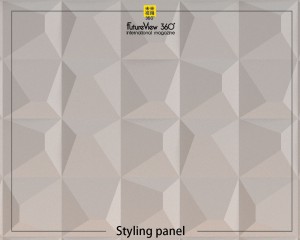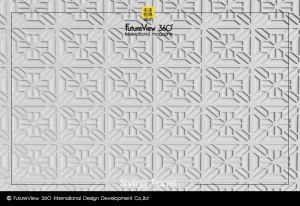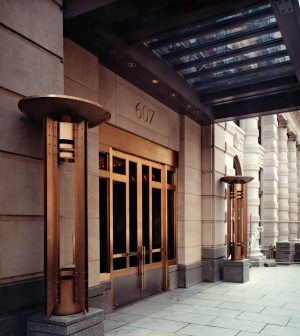Château de Chambord
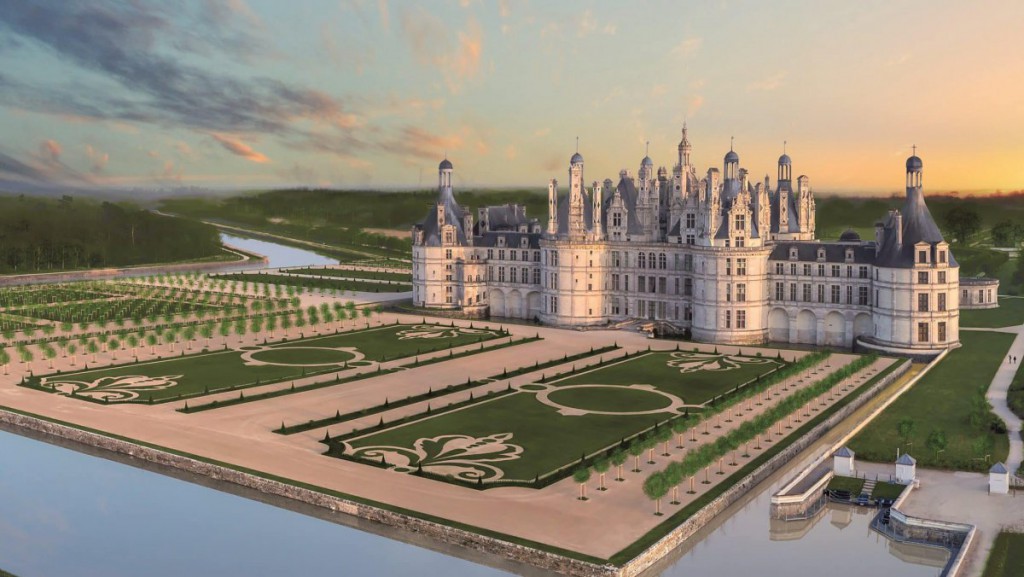
The Château de Chambord (French pronunciation: [ʃɑto də ʃɑ̃bɔʁ]) in Chambord, Loir-et-Cher, France, is one of the most recognisable châteaux in the world because of its very distinctive French Renaissance architecture which blends traditional French medieval forms with classical Renaissance structures. The building, which was never completed, was constructed by King Francis I of France.
Chambord is the largest château in the Loire Valley; it was built to serve as a hunting lodge for Francis I, who maintained his royal residences at the Château de Blois and Amboise. The original design of the Château de Chambord is attributed, though with some doubt, to Domenico da Cortona; Leonardo da Vinci may also have been involved.
Chambord was altered considerably during the twenty-eight years of its construction (1519–1547), during which it was overseen on-site by Pierre Nepveu. With the château nearing completion, Francis showed off his enormous symbol of wealth and power by hosting his old archrival, Emperor Charles V, at Chambord.
In 1792, in the wake of the French Revolution, some of the furnishings were sold and timber removed. For a time the building was left abandoned, though in the 19th century some attempts were made at restoration. During the Second World War, art works from the collections of the Louvre and the Château de Compiègne were moved to the Château de Chambord. The château is now open to the public, receiving 700,000 visitors in 2007. Flooding in June 2016 damaged the grounds but not the château itself.
ChâteaudeChambord(法語發音:[ʃɑtodəʃɑbɔʁ])位於法國Loir-et-Cher的Chambord,是世界上最知名的城堡之一,因為其獨特的法國文藝復興時期建築融合了傳統的法國中世紀形式具有古典文藝復興時期的結構。該建築從未完工,由法國國王弗朗西斯一世建造。
香波堡是盧瓦爾河谷最大的城堡;它的建造是為了弗朗西斯一世(Francis I)的狩獵小屋,他在布洛瓦城堡(ChâteaudeBlois)和昂布瓦茲(Amboise)保留了皇家住所。 ChâteaudeChambord的原始設計雖然有些疑問,卻歸功於Domenico da Cortona;萊昂納多達芬奇也可能參與其中。
Chambord在其建造的二十八年(1519-1547)期間發生了相當大的變化,其間由Pierre Nepveu在現場監督。隨著城堡接近完工,弗朗西斯在香波堡舉辦了他的老對手皇帝查理五世,展示了他巨大的財富和權力像徵。
1792年,法國大革命之後,一些家具被出售,木材被拆除。有一段時間,建築物被遺棄,儘管在19世紀,有一些嘗試是在恢復。在第二次世界大戰期間,盧浮宮和貢比涅城堡(ChâteaudeCompiègne)的藝術作品被搬到了尚博爾城堡(ChâteaudeChambord)。該城堡現在向公眾開放,2007年接待了70萬遊客。2016年6月的洪水破壞了土地,但不是城堡本身。
General information
Status:Extant
Architectural style:French Renaissance
Classical Renaissance
Location:Chambord, Loir-et-Cher, France
Address:Chateau 41250, Chambord, France
Coordinates: 47.616342°N 1.516962°ECoordinates: 47.616342°N 1.516962°E
Construction started:1519
Completed:1547
Height:56m
Design and construction
Architect:Domenico da Cortona
Structural engineer:Pierre Nepveu
一般信息
狀態:現存
建築風格:法國文藝復興
古典文藝復興
地點:法國Loir-et-Cher的Chambord
地址:法國香波堡城堡41250
坐標:47.616342°N 1.516962°ECoordinates:47.616342°N 1.516962°E
施工開始:1519年
完成:1547
身高:56米
設計和施工
建築師:Domenico da Cortona
結構工程師:Pierre Nepveu
Architecture
Châteaux in the 16th century departed from castle architecture; while they were off-shoots of castles, with features commonly associated with them, they did not have serious defences. Extensive gardens and water features, such as a moat, were common amongst châteaux from this period. Chambord is no exception to this pattern. The layout is reminiscent of a typical castle with a keep, corner towers, and defended by a moat. Built in Renaissance style, the internal layout is an early example of the French and Italian style of grouping rooms into self-contained suites, a departure from the medieval style of corridor rooms. The massive château is composed of a central keep with four immense bastion towers at the corners. The keep also forms part of the front wall of a larger compound with two more large towers. Bases for a possible further two towers are found at the rear, but these were never developed, and remain the same height as the wall. The château features 440 rooms, 282 fireplaces, and 84 staircases. Four rectangular vaulted hallways on each floor form a cross-shape.
The château was never intended to provide any form of defence from enemies; consequently the walls, towers and partial moat are decorative, and even at the time were an anachronism. Some elements of the architecture—open windows, loggia, and a vast outdoor area at the top—borrowed from the Italian Renaissance architecture—are less practical in cold and damp northern France.
The roofscape of Chambord contrasts with the masses of its masonry and has often been compared with the skyline of a town: it shows eleven kinds of towers and three types of chimneys, without symmetry, framed at the corners by the massive towers. The design parallels are north Italian and Leonardesque. Writer Henry James remarked “the towers, cupolas, the gables, the lanterns, the chimneys, look more like the spires of a city than the salient points of a single building.”
One of the architectural highlights is the spectacular open double-spiral staircase that is the centrepiece of the château. The two spirals ascend the three floors without ever meeting, illuminated from above by a sort of light house at the highest point of the château. There are suggestions that Leonardo da Vinci may have designed the staircase, but this has not been confirmed. Writer John Evelyn said of the staircase “it is devised with four [sic] entries or ascents, which cross one another, so that though four persons meet, they never come in sight, but by small loopholes, till they land. It consists of 274 steps (as I remember), and is an extraordinary work, but of far greater expense than use or beauty.”
The château also features 128 metres of façade, more than 800 sculpted columns and an elaborately decorated roof. When Francis I commissioned the construction of Chambord, he wanted it to look like the skyline of Constantinople.
The château is surrounded by a 52.5-square-kilometre (13,000-acre) wooded park and game reserve maintained with red deer, enclosed by a 31-kilometre (19-mile) wall. The king’s plan to divert the Loire to surround the château came about only in a novel; Amadis of Gaul, which Francis had translated. In the novel the château is referred to as the Palace of Firm Isle.
Chambord’s towers are atypical of French contemporary design in that they lack turrets and spires. In the opinion of author Tanaka, who suggests Leonardo da Vinci influenced the château’s design, they are closer in design to minarets of 15th-century Milan.
The design and architecture of the château inspired William Henry Crossland for his design of what is known as the Founder’s building at Royal Holloway, University of London. The Founder’s Building features very similar towers and layout but was built using red bricks.
建築
16世紀的城堡離開了城堡建築;雖然他們是城堡的射擊,具有通常與他們相關的特徵,但他們沒有嚴重的防禦。這一時期,城堡中廣泛的花園和水景,如護城河。香波堡也不例外。佈局讓人想起典型的城堡,有一個保持,角塔,並由護城河保衛。內部佈局以文藝復興風格建造,是法國和意大利風格的早期典範,將客房分組為自助式套房,與中世紀風格的走廊客房不同。巨大的城堡由一個中央保留著四個巨大的堡壘塔樓。保持也形成了一個較大的化合物的前牆的一部分,有兩個更大的塔。在後方可以找到另外兩座塔樓的基座,但這些基座從未開發過,並且與牆壁保持相同的高度。城堡擁有440間客房,282個壁爐和84個樓梯。每層四個矩形拱形走廊形成十字形。
城堡從未打算向敵人提供任何形式的防禦;因此,牆壁,塔樓和部分護城河都是裝飾性的,即使在當時也是不合時宜的。建築的一些元素 – 開放式窗戶,涼廊和頂部廣闊的戶外區域 – 從意大利文藝復興時期的建築中藉來 – 在寒冷潮濕的法國北部不太實用。
Chambord的屋頂景觀與其磚石的大眾形成鮮明對比,並且經常與城鎮的天際線進行比較:它展示了十一種塔樓和三種類型的煙囪,沒有對稱性,在角落處被巨大的塔樓框住。設計平行線是北意大利和Leonardesque。作家亨利詹姆斯評論說“塔樓,圓屋頂,山牆,燈籠,煙囪,看起來更像是城市的尖頂,而不是單個建築的突出點。”
其中一個建築亮點是壯觀的開放雙螺旋樓梯,是城堡的核心。兩個螺旋線在沒有相遇的情況下上升到三個樓層,從城堡的最高點處的一個燈塔上方照亮。有人認為列奧納多達芬奇可能設計了樓梯,但這一點尚未得到證實。作家約翰伊夫林談到了樓梯“它設計有四個[sic]條目或上升,彼此交叉,所以雖然有四個人見面,但它們從未出現過,但是由於漏洞很小,直到它們降落。它由274步(我記得),這是一項非凡的工作,但卻遠遠超過了使用或美麗。“
城堡還擁有128米的外觀,800多個雕刻柱和精心裝飾的屋頂。當弗朗西斯一世委託Chambord建造時,他希望它看起來像君士坦丁堡的天際線。
城堡周圍環繞著佔地52.5平方公里(13,000英畝)的樹木繁茂的公園和用紅鹿維護的野生動物保護區,周圍環繞著31公里(19英里)的牆壁。國王將盧瓦爾河轉移到城堡周圍的計劃只出現在小說中;弗朗西斯翻譯過的高盧阿馬迪斯。在小說中,城堡被稱為堅固宮殿。
香波堡的塔樓是法國當代設計的典型,因為它們沒有砲塔和尖塔。作者坦納卡認為萊昂納多達芬奇影響了城堡的設計,他們在設計上更接近15世紀米蘭的尖塔。
城堡的設計和建築激發了威廉·亨利·克羅斯蘭德(William Henry Crossland)設計倫敦大學皇家霍洛威(Royal Holloway)的創始人建築。方正大廈擁有非常相似的塔樓和佈局,但是使用紅磚建造。
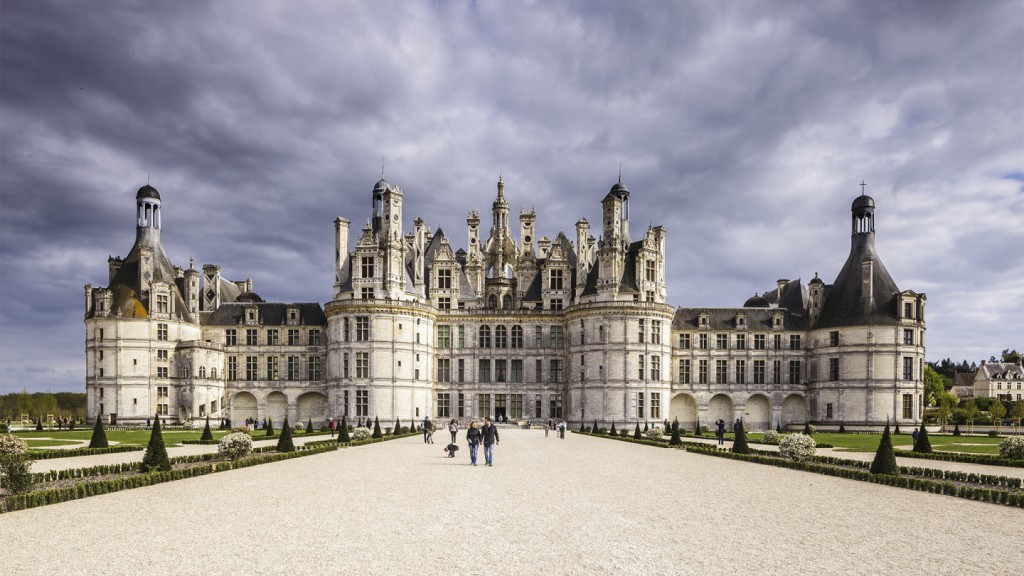
Who designed the Château de Chambord is a matter of controversy. The original design is attributed, though with several doubts, to Domenico da Cortona, whose wooden model for the design survived long enough to be drawn by André Félibien in the 17th century. In the drawings of the model, the main staircase of the keep is shown with two straight, parallel flights of steps separated by a passage and is located in one of the arms of the cross. According to Jean Guillaume, this Italian design was later replaced with the centrally located spiral staircase, which is similar to that at Blois, and a design more compatible with the French preference for spectacular grand staircases. However, “at the same time the result was also a triumph of the centralized layout—itself a wholly Italian element.” In 1913 Marcel Reymond suggested that Leonardo da Vinci, a guest of Francis at Clos Lucé near Amboise, was responsible for the original design, which reflects Leonardo’s plans for a château at Romorantin for the King’s mother, and his interests in central planning and double-spiral staircases; the discussion has not yet concluded, although most scholars now agree that Leonardo was at least responsible for the design of the central staircase.
Archeological findings by Jean-Sylvain Caillou & Dominic Hofbauer have established that the lack of symmetry of some facades derives from an original design, abandoned shortly after the construction began, and which ground plan was organised around the central staircase following a central gyratory symmetry. Such a rotative design has no equivalent in architecture at this period of history, and appears reminiscent of Leonardo Da Vinci’s works on hydraulic turbines, or the helicopter. Had it been respected, it is believed that this unique building could have featured the quadruple-spiral open staircase, strangely described by John Evelyn and Andrea Palladio although it was never built.
Regardless of who designed the château, on 6 September 1519 Francis Pombriant was ordered to begin construction of the Château de Chambord. The work was interrupted by the Italian War of 1521–1526, and work was slowed by dwindling royal funds and difficulties in laying the structure’s foundations. By 1524, the walls were barely above ground level. Building resumed in September 1526, at which point 1,800 workers were employed building the château. At the time of the death of King Francis I in 1547, the work had cost 444,070 livres.
設計ChâteaudeChambord的人是一個有爭議的問題。最初的設計歸功於多梅尼科·達科爾托納(Domenico da Cortona),其設計的木製模型在17世紀由安德烈·費利比恩(AndréFélibien)繪製得足夠長。在該模型的圖中,保持器的主樓梯示出為具有由通道分開的兩個平行的平行台階,並且位於十字架的一個臂中。根據Jean Guillaume的說法,這個意大利設計後來被中央位置的螺旋樓梯所取代,這個樓梯類似於布洛瓦,並且設計更符合法國人對壯觀的樓梯的偏好。然而,“與此同時,結果也是集中式佈局的勝利 – 本身就是一個完全意大利元素。” 1913年,Marcel Reymond建議在Amboise附近ClosLucé的Francis的賓客Leonardo da Vinci負責原始設計,這反映了Leonardo為Romorantin為國王的母親建造城堡的計劃,以及他對中央計劃和雙重利益的興趣。螺旋樓梯;討論尚未結束,儘管大多數學者現在都同意萊昂納多至少對中央樓梯的設計負責。
Jean-Sylvain Caillou和Dominic Hofbauer的考古發現表明,一些立面缺乏對稱性源於原始設計,在施工開始後不久就被廢棄,並且中央樓梯圍繞中心旋轉對稱地組織了平面圖。在這段歷史時期,這種旋轉設計在建築方面沒有相應之處,讓人聯想到萊昂納多達芬奇在水輪機或直升機上的作品。如果它受到尊重,相信這座獨特的建築可能會有四重螺旋形的開放式樓梯,約翰·伊夫林和安德烈·帕拉迪奧奇怪地描述了它雖然從未建造過。
無論是誰設計了城堡,1519年9月6日,Francis Pombriant被命令開始建造ChâteaudeChambord。這項工作被1521年至1526年的意大利戰爭打斷,由於皇家資金減少以及鋪設建築物基礎的困難,工作進展緩慢。到1524年,牆壁幾乎不在地面以上。建築於1526年9月恢復,當時僱用了1,800名工人建造城堡。在1547年弗朗西斯一世國王去世時,這項工作耗資444,070里弗。
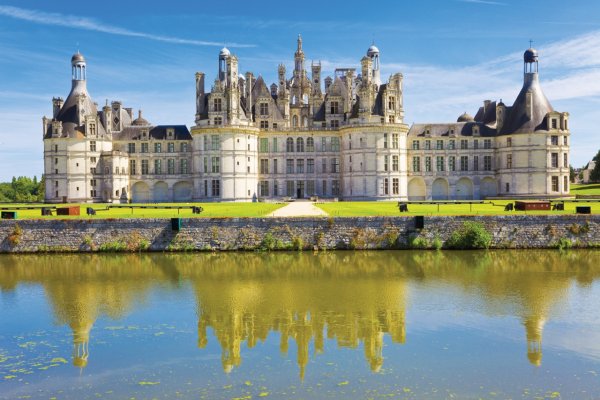
The château was built to act as a hunting lodge for King Francis I; however, the king spent barely seven weeks there in total, that time consisting of short hunting visits. As the château had been constructed with the purpose of short stays, it was not practical to live in on a longer-term basis. The massive rooms, open windows and high ceilings meant heating was impractical. Similarly, as the château was not surrounded by a village or estate, there was no immediate source of food other than game. This meant that all food had to be brought with the group, typically numbering up to 2,000 people at a time.
As a result of all the above, the château was completely unfurnished during this period. All furniture, wall coverings, eating implements and so forth were brought specifically for each hunting trip, a major logistical exercise. It is for this reason that much furniture from the era was built to be disassembled to facilitate transportation. After Francis died of a heart attack in 1547, the château was not used for almost a century.
For more than 80 years after the death of King Francis I, French kings abandoned the château, allowing it to fall into decay. Finally, in 1639 King Louis XIII gave it to his brother, Gaston d’Orléans, who saved the château from ruin by carrying out much restoration work.
King Louis XIV had the great keep restored and furnished the royal apartments. The king then added a 1,200-horse stable, enabling him to use the château as a hunting lodge and a place to entertain a few weeks each year. Nonetheless, Louis XIV abandoned the château in 1685.
From 1725 to 1733, Stanislas Leszczyński (Stanislas I), the deposed King of Poland and father-in-law of King Louis XV, lived at Chambord. In 1745, as a reward for valour, the king gave the château to Maurice de Saxe, Marshal of France who installed his military regiment there. Maurice de Saxe died in 1750 and once again the colossal château sat empty for many years.
城堡的建造是為了弗朗西斯一世的狩獵小屋;然而,國王總共花了不到七個星期,那個時間包括短暫的狩獵訪問。由於城堡的建造目的是為了短期居住,因此長期居住是不切實際的。寬敞的房間,開著的窗戶和高高的天花板意味著加熱是不切實際的。同樣地,由於城堡沒有被村莊或莊園所包圍,除了遊戲之外,沒有直接的食物來源。這意味著所有食物都必須與團體一起攜帶,通常一次最多可容納2,000人。
由於上述所有原因,這座城堡在此期間完全沒有家具。所有家具,牆壁覆蓋物,餐具等都是專門為每次狩獵旅行而進行的,這是一項重要的後勤活動。正是由於這個原因,這個時代的許多家具被拆開以便於運輸。弗朗西斯於1547年因心髒病發作去世後,這座城堡近一個世紀未被使用。
在弗朗西斯一世去世後的80多年裡,法國國王拋棄了城堡,使其陷入腐朽之中。最後,在1639年,路易十三國王將它交給了他的兄弟加斯東·奧爾良(Gaston d’Orléans),他通過進行大量修復工作拯救了城堡。
國王路易十四有偉大的保持恢復和皇家公寓。國王然後增加了一個1,200馬的馬厩,使他可以使用城堡作為狩獵小屋和每年招待幾週的地方。儘管如此,路易十四還是在1685年放棄了城堡。
從1725年到1733年,被廢土的波蘭國王斯坦尼斯拉斯·萊什琴斯基(斯坦尼斯拉斯一世)和路易十五國王的岳父住在香波堡。 1745年,為了獎勵英勇,國王將城堡交給法國元帥莫里斯德薩克斯,他在那里安裝了他的軍團。莫里斯·德·薩克斯(Maurice de Saxe)於1750年去世,這座巨大的城堡再次空無一人。
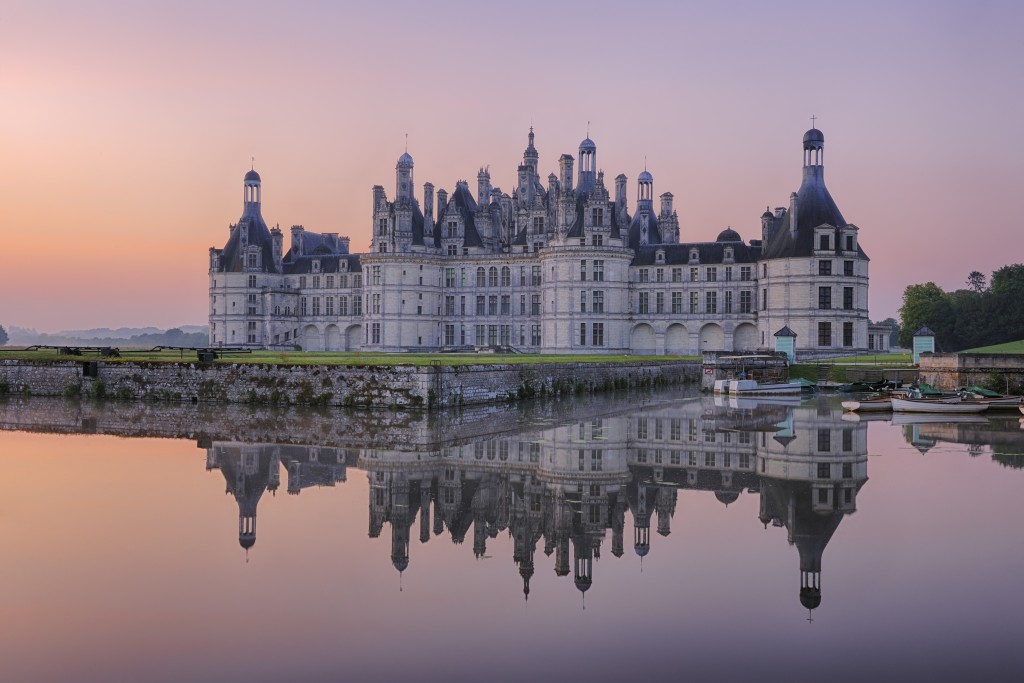
In 1792, the Revolutionary government ordered the sale of the furnishings; the wall panellings were removed and even floors were taken up and sold for the value of their timber, and, according to M de la Saussaye, the panelled doors were burned to keep the rooms warm during the sales; the empty château was left abandoned until Napoleon Bonaparte gave it to his subordinate, Louis Alexandre Berthier. The château was subsequently purchased from his widow for the infant Duke of Bordeaux, Henri Charles Dieudonné (1820–1883) who took the title Comte de Chambord. A brief attempt at restoration and occupation was made by his grandfather King Charles X (1824–1830) but in 1830 both were exiled. In Outre-Mer: A Pilgrimage Beyond the Sea, published in the 1830s, Henry Wadsworth Longfellow remarked on the dilapidation that had set in: “all is mournful and deserted. The grass has overgrown the pavement of the courtyard, and the rude sculpture upon the walls is broken and defaced”. During the Franco-Prussian War (1870–1871) the château was used as a field hospital.
The final attempt to make use of the colossus came from the Comte de Chambord but after the Comte died in 1883, the château was left to his sister’s heirs, the titular Dukes of Parma, then resident in Austria. First left to Robert, Duke of Parma, who died in 1907 and after him, Elias, Prince of Parma. Any attempts at restoration ended with the onset of World War I in 1914. The Château de Chambord was confiscated as enemy property in 1915, but the family of the Duke of Parma sued to recover it, and that suit was not settled until 1932; restoration work was not begun until a few years after World War II ended in 1945. The Château and surrounding areas, some 5,440 hectares (13,400 acres; 21.0 sq mi), have belonged to the French state since 1930.
In 1939, shortly before the outbreak of World War II, the art collections of the Louvre and Compiègne museums (including the Mona Lisa and Venus de Milo) were stored at the Château de Chambord. An American B-24 Liberator bomber crashed onto the château lawn on 22 June 1944. The image of the château has been widely used to sell commodities from chocolate to alcohol and from porcelain to alarm clocks; combined with the various written accounts of visitors, this made Chambord one of the best known examples of France’s architectural history. Today, Chambord is a major tourist attraction, and in 2007 around 700,000 people visited the château.
After unusually heavy rainfall, Chambord was closed to the public from 1 to 6 June 2016. The river Cosson, a tributary of the Loire, flooded its banks and the chateau’s moat. Drone photography documented some of the peak flooding. The French Patrimony Foundation described effects of the flooding on Chambord’s 13,000-acre property. The 20-mile wall around the chateau was breached at several points, metal gates were torn from their framing, and roads were damaged. Also, trees were uprooted and certain electrical and fire protection systems were put out of order. However, the chateau itself and its collections reportedly were undamaged. The foundation observed that paradoxically the natural disaster effected Francis I’s vision that Chambord appear to rise from the waters as if it were diverting the Loire. Repairs are expected to cost upwards of a quarter-million dollars.
1792年,革命政府下令出售家具;拆除了牆面板,甚至地板被拿走並以木材的價格出售,據M de la Saussaye說,在銷售期間,鑲板門被燒毀以保持房間溫暖;空的城堡被遺棄,直到拿破崙波拿巴把它交給他的下屬路易斯亞歷山大·貝蒂爾。隨後,該城堡從他的寡婦那裡購買了嬰兒公爵波爾多,HenriCharlesDieudonné(1820-1883),他獲得了Comte de Chambord的稱號。他的祖父查理十世(King Charles X)(1824-1830)在恢復和占領方面作了簡短的嘗試,但在1830年他們都被放逐了。在19世紀30年代出版的“Outre-Mer:超越海洋的朝聖”中,亨利·沃茲沃思·朗費羅評論說:“一切都是悲傷和荒蕪的。草地已經長滿了庭院的路面,粗糙的雕塑在牆壁破碎,污損“。在法國 – 普魯士戰爭期間(1870-1871),城堡被用作野戰醫院。
使用巨像的最後嘗試來自Comte de Chambord,但是在Comte於1883年去世後,城堡留給了他姐姐的繼承人,當時居住在奧地利的名譽公爵帕爾馬公爵。首先留給帕爾馬公爵羅伯特,他於1907年去世,之後是帕爾馬王子以利亞斯。 1914年第一次世界大戰開始時,任何恢復嘗試都結束了。1915年,尚博城堡被沒收作為敵人財產,但是帕爾馬公爵的家族起訴要追回它,直到1932年才解決這個訴訟。修復工作直到1945年第二次世界大戰結束後幾年才開始。城堡和周邊地區約有5,440公頃(13400英畝; 21.0平方英里),自1930年以來一直屬於法國。
1939年,在第二次世界大戰爆發前不久,盧浮宮和貢比涅博物館(包括蒙娜麗莎和維納斯米洛)的藝術收藏品被儲存在尚博爾城堡(ChâteaudeChambord)。 1944年6月22日,一架美國B-24解放者轟炸機墜毀在城堡草坪上。城堡的形像被廣泛用於銷售從巧克力到酒精,從瓷器到鬧鐘的商品;結合訪客的各種書面記錄,這使得香波堡成為法國建築史上最著名的例子之一。今天,香波堡是一個主要的旅遊景點,2007年約有70萬人參觀了城堡。
在異常強降雨之後,Chambord於2016年6月1日至6日對公眾開放.Cowon河是盧瓦爾河的一條支流,淹沒了河岸和城堡的護城河。無人機攝影記錄了一些洪水氾濫。法國Patrimony基金會描述了洪水對香波堡13,000英畝土地的影響。城堡周圍20英里長的牆壁在幾個地方被突破,金屬門從他們的框架中被撕裂,道路被損壞。此外,樹木被連根拔起,某些電氣和消防系統也被排除在外。然而,據報導,城堡本身及其收藏品完好無損。基金會觀察到,自然災害自然災害影響了弗朗西斯一世的願景,即香波河似乎從水中升起,彷彿它正在轉移盧瓦爾河。維修費用預計將超過25萬美元。

Influence
The Château de Chambord has further influenced a number of architectural and decorative elements across Europe. Château de Chambord was the model for the reconstruction and new construction of the original Schwerin Palace between 1845 and 1857.
Yet in the later half of the nineteenth century, the château’s style is seen proliferating across the United Kingdom, influencing the Founder’s Building at Royal Holloway, University of London, designed by William Henry Crossland and the main building of Fettes College in Edinburgh, designed by David Bryce in 1870. Between 1874 and 1889, the country house in Buckinghamshire, Waddesdon Manor, was built with similar architectural frameworks as the Château de Chambord, disseminated via the architect Gabriel-Hippolyte Destailleur. For instance, the twin staircase towers, on the north facade, were inspired by the staircase tower at the Château. However, following the theme of unparalleled luxury at Waddesdon, the windows of the towers at Waddesdon were glazed, unlike those of the staircase at Chambord, and were far more ornate.
影響
ChâteaudeChambord酒店進一步影響了歐洲各地的建築和裝飾元素。 ChâteaudeChambord是1845年至1857年間原始什未林宮重建和新建的典範。
然而在十九世紀下半葉,城堡的風格在整個英國蔓延,影響了倫敦大學皇家霍洛威的創始人大樓,由William Henry Crossland和愛丁堡Fettes學院的主樓設計,由大衛布萊斯於1870年。在1874年至1889年間,位於白金漢郡的鄉間別墅Waddesdon Manor建造了與ChâteaudeChambord相似的建築框架,由建築師Gabriel-Hippolyte Destailleur傳播。例如,北立面的雙層樓梯塔樓的靈感來自城堡的樓梯塔樓。然而,繼Waddesdon無與倫比的奢華主題之後,Waddesdon塔樓的窗戶與Chambord樓梯的窗戶不同,並且更加華麗。

FROM:https://en.wikipedia.org/wiki/Ch%C3%A2teau_de_Chambordv
FROM:Loire, France: Château de Chambord
FROM:4K – Château de Chambord – France
Don’t you think it’s addictive?
Want to know more about the beauty of architecture?
Come and join our members to explore the beauty of architectural design.
覺得看得不過癮嗎?
想要知道更多建築之美嗎?
快來加入我們的會員,一同探索建築設計之美。
The above article is purely for appreciation and sharing purposes, as well as the construction of new technology and the public can be in-depth understanding of the information at the same time there are sources, will be able to query, no use of the document as a commercial transaction, if illegal, please inform the We will immediately remove the site, thank you for cooperation.
以上文章純粹作為欣賞及分享用途,以及將建築新型技術傳遞給與大眾能夠深入了解,同時資料還有來源,將可查詢,絕無使用該文件資料作為商業交易行為,如有違法請務必告知該網站我們將立即處理撤除,謝謝合作。

